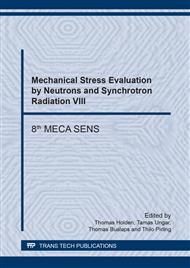p.66
p.74
p.83
p.91
p.101
p.107
p.114
p.123
p.131
Evolution of Residual Stresses in Linear Deposition Wire-Based Cladding of Ti-6Al-4V
Abstract:
Neutron diffraction and curvature measurements were conducted to investigate the residual stresses associated with Plasma Transferred Arc Cladding (PTA) of Ti-6Al-4V on a substrate of the same material. The wire-feed PTA coupled with 3-axis CNC machine was used as an Additive Manufacturing (AM) technique to build parts. A combination of the process parameters was chosen to investigate their effects on residual stress evolution. Neutron Diffraction (ND) measurements of residual strains were performed on the SALSA instrument at the Institut Laue-Langevin (ILL), Grenoble, France. Longitudinal stresses were also inferred by using a Coordinate Measurement Machine (CMM) and Euler-Bernoulli beam theorem. Furthermore, Optical Microscopy (OM) of the cross section of the parts was used to analyse the microstructural evolution. The results show the effect of shorter and longer ‘dwell time’ between layers on the evolution of residual stresses.
Info:
Periodical:
Pages:
101-106
Citation:
Online since:
August 2017
Price:
Сopyright:
© 2017 Trans Tech Publications Ltd. All Rights Reserved
Share:
Citation:


